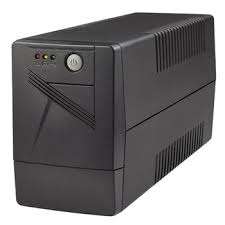UNINTERRUPTIBLE POWER SUPPLY (UPS) SHOP IN KENYA proftech
Uninterruptible power supply maintenance and Servicing (UPS) is an electrical apparatus that provides emergency power to a load when the input power source or main power fails. A UPS differs from an auxiliary emergercy power system, in that it will provide near-instantaneous protection from input power interruptions, by supplying energy stored in batteries, The on-battery run-time of most uninterruptible power sources is relatively short (only a few minutes) but sufficient to start a standby power source or properly shut down the protected equipment. It is a type of continual power supply
How An Uninterruptible power supply maintenance and Servicing Is Maintained
Uninterruptible Power Supply preventive maintenance can be customized to your specific requirement and performed on a monthly, quarterly, semi-annual and annual basis to ensure that your mission critical Backup Power Supply equipment operate in their top condition.Maintenance is a must for all computers and all computer network components. Without maintenance, developing problems are left unchecked, updates and upgrades don’t get installed, and an accurate picture of network and server operation never develops. Planning for the maintenance of any network component can be a challenge and planning for the maintenance of your uninterruptible power supply (UPS) system is perhaps most challenging. Regardless of the apparent challenges this important task needs addressed.
What Maintenance Achieves and Why it’s Important
In short, UPS system maintenance helps ensure that your system is going to perform dependably regardless of changing circumstances. The impact of variables such as power interruptions, variances in voltage and frequency, and other disruptions are minimized through the regular attention given to each data center component. Regular maintenance checks reduce the possibility of unplanned downtime and help ensure that all data center components are operating at peak efficiency. A well-functioning data center provides secure and stable computing power for all employees. Since well-maintained data centers and UPS systems function more effectively, they contribute to overall productivity – and thus to your bottom line.
Uninterruptible power supply maintenance and Servicing Maintenance Process
Maintaining a UPS system is a multi-step process that includes inspection, analysis, and testing.
- First a visual check is conducted on the physical components. Anything found to be worn, loose, burned, or otherwise compromised will be removed and replaced with new components.
- Next all equipment housings are cleaned and vacuumed by hand. Removing dust and minute debris helps maintain the optimal operating temperature of each component; environmental systems work more effectively in spaces where air is able to freely circulate and keep electronics cool. Even though there are few moving parts inside a UPS system, dust can still penetrate module chassis and interfere with necessary function.
- Batteries and capacitors have the potential to leak fluid onto surrounding components. A visual check of each battery will be performed during maintenance.
- The HVAC system and climate controls tasked with maintaining a stable environment inside the space housing the UPS must itself be checked. Depending on the nature of this system and the extent of its infrastructure, this stage may take some extra time to complete.
- An operational test will be run on the entire system, including batteries. The report generated at the end of this test will allow technicians to analyze functioning parameters and gauge the remaining longevity of all battery strings and cells.
Detecting the First Sign of Trouble
All electrical devices generate some degree of heat. This heat must be safely channeled away from the device through the use of fans, heat sinks, outside cooling agents, and a stable environment. Some of the steps mentioned above are done to help create a stable environment optimal for ups system This stability is created through temperature moderation, humidity control, and air circulation. When the HVAC system is working correctly and when all heat regulation components within the system are also functioning, there should be no heat spikes. The only way to detect spots of irregular heat is with a thermal scan. This scan gives particular attention to all the electrical connections present in the system. These points of connections are apt to generate heat when not working correctly; this initial malfunction can indicate an existing problem or one that is in development. A thermal scan will detect these early warning signs and give technicians a chance to deploy early intervention strategies.
Assessing Power Generation and Use
Another important part of Uninterruptible power supply maintenance and Servicing is the testing of the system that manages power transfer throughout the rest of the center and its modules. This test assesses the circuit breakers and transfer switches within the UPS; these components are responsible for regulating the flow of power and, if not working correctly, will supply too much or too little to the other components. The maintenance bypasses must also be checked at this stage to make sure that they’re working within their optimal operating parameters.
Most UPS systems are designed to function for a short, albeit critical, period of time. This length of time allows for maintenance intervention during planned or unplanned interruptions in power before the system is restored to its usual source. Some organizations require a backup power system that is capable of generating its own electricity in the case of a supply disruption or stoppage. UPS systems connected to a backup generator are likely to require additional maintenance checks to assess its function.
The Ideal Maintenance Schedule
Not every step in this maintenance list will be conducted during every check. Doing so would cause unnecessary interruption in organization function and demand the presence of skilled technicians when they really aren’t required.
A visual inspection of component integrity should be conducted once each quarter. This inspection can be completed in a short period of time and requires little special training; with some instruction any technician can perform this check. The check of the climate control system and visual check of the batteries should take place once every six months; vacuuming can take place at the same time.
An operational test and complete thermal scan should be conducted once each year. This may require you to arrange a maintenance check from your UPS company if you don’t have qualified technicians on staff. Every two years test the power system, battery backups, and any generators.
If possible, plan these checks well in advance. Good advance planning allows for adequate preparation for any system downtime that may be required. Because downtime is costly in terms of time and lost productivity, advance preparation is necessary to minimize any negative impacts this period of time may have on your organization.
Between Each Maintenance Check
As thorough as all these maintenance checks sound, there is actually additional work that should be done in between checks. This work will make maintenance simpler and help your team respond to unexpected circumstances. Make an inventory list of all spare parts and materials; keep a running tally of materials used so new items can be ordered and kept on hand. Coordinate the maintenance schedule with larger workplace operations so conflicts in labor and budget allowances are avoided. And finally, make an effort to keep up with the latest developments in the UPS industry. Understanding the larger trends will help your organization adapt to the many changes likely to impact your operations.
Uninterruptible power supply specifications
| UPS Output: | Specification |
| Voltage | 120Vac |
| Regulation | ± 3% |
| Frequency | 60Hz nominal, synchronized, ± 0.05% in battery mode |
| Power Rating | 1000VA |
| Load Power Factor | 0.6 |
| Load Crest Factor | 3:1 |
| Transfer Time | 5 milliseconds |
| Current | 8.3 Amps |
| Overload Capability | 150% |
| Waveform | Sine-wave |
| Distortion | < 3% for non-linear loads |
| Transient Regulation | ± 5% for a 100% step load change |
| UPS Input | |
| Voltage | 120V |
| Voltage Range | +10%, -15% |
| Frequency | 60Hz |
| Maximum Current | 12.8 Amps |
| Power Factor | 0.9 |
| UPS Battery | |
| Type | Sealed lead-acid, maintenance free |
| Rating | 12V, 7AH |
| Number of Cells | 3 |
| Diagnostics | Periodic automatic test |
| Autonomy Time | 10 minutes at full load |
| Recharge Time | 20 times the outage to 90% capacity. |
| Overall System | |
| Architecture | Fault-tolerant, Double Conversion, On-Line, Modular |
| Configuration | Single-Phase Input and Output |
| Bypass | Automatic operation |
| Efficiency | 85% |
| Operation | Fully Automatic or Manual Operation, |
| Control Panel/Metering | LED Display, Button Controls, No Metering |
| Diagnostics & Self Test | Self test on startup and periodically |
Communications | |
| User Interface | RS232 port and Novell style contacts |
| Networks | Via an Ethernet or Token Ring adapter |
| SNMP | Via an SNMP adapter |
| Modem | Via a modem adapter |
| Mechanical | |
| Input | Hardwired |
| Output | Hardwired |
| Weight | 15.8 kg (35 lbs) |
| Dimensions (LxWxH) | 499 x 134 x 226 mm (19.6 x 5.3 x 8.9 inches) |
| Environmental | |
| Audible Noise | < 50 dBA |
| Operating Temperature | 0° C to 40° C |
| Storage Temperature | – 20° C to + 60° C |
| Relative Humidity | 5 – 95% non-condensing |
| Altitude | 1000m without derating |
| Safety | UL 1778 |
| EMC – Emissions | FCC Class A |
| EMC – Immunity | Not Applicable |
| Surge Suppression | IEEE 587 (ANSI C62.41) |
| CMNR | > 60dB |
| TMNR | > 80dB |
| Packaging | No CFC’s, Recyclable |
| Options | |
| Battery Packs | Battery Modules and special long autonomy solutions |
| Maintenance Bypass | |
| Galvanic Isolation |
UPS Output Specifications
| Voltage | The UPS output voltage must match the requirement of the load. In North America this voltage is 120Vac, in most of Europe 230Vac is used and the rest of the world is 220Vac. |
| Regulation | The regulation specification is the maximum expected deviation for the normal output voltage (e.g. 120Vac) that is expected over the entire range of operating conditions (e.g. load, temperature, altitude). For Off-Line systems the regulation spec refers to the battery backup mode. For On-Line systems the spec is normally ± a few percent an is valid for both the normal and battery backup modes. |
| Frequency | The frequency of the UPS output must match the requirements of the load. Switch-mode power supplies have a wide (47 – 63 Hz) range to be able to operate from either 50 or 60Hz. Other loads may require either 50 or 60Hz. |
| Power Rating | To completely specify a UPS, both the Volt-Ampere (VA) and wattage (Watts) rating must be known. See the section on “Understanding Watts, VA and Power Factor” for an in-depth explanation. |
| Load Power Factor | A power factor (p.f.) in the 0.6 to 0.8 range is typical. A p.f. rating of 0.6 to 0.7 is good for a switch-mode power supply. A p.f of 0.8 is typical for older UPS equipment designs used before the widespread used of computers. |
| Load Crest Factor | Most loads used in modern equipment, including computers, require a peak current that is much higher than what is required by a simple load such as a light bulb. The UPS must be able to supply this peak current. The Load Crest Factor is the ratio of the peak to the average (RMS) current. |
 | |
| Transfer Time | In an On-Line system the transfer time refers to a change from the bypass source to the UPS and vise-versa. A typical time is ¼ of a cycle or about 5-6 milliseconds. In an Off-Line system the transfer time refers to the change from the utility source to the inverter when there is a power outage and is about 5 to 10 milliseconds. |
| Current | The output current refers to the maximum current available at the normal output voltage. |
| Overload Capability | If more load is added to a UPS and the new total is more than the rating, the UPS must be able to continue to function. At typical Overload specification is 1.25% for 10 minutes or 150% for 1 minute. |
| Waveform | Not all UPS products have a sine-wave output and most modern loads do not require a perfect sine-wave source. Lower cost UPS equipment will have a quasi square-wave or a step sine-wave output waveform. |
UPS Output Specifications
| Distortion | If the UPS has a sine-wave output a distortion figure indicates how good the wave shape is. A typical distortion value is 3% for linear loads and 5% for non-linear load. |
| Transient Regulation | When a load is added or removed the UPS inverter has to adjust. The maximum amount the output voltage deviates from the nominal value indicates the transient regulation. If the voltage deviates too much, some loads will fail. |
UPS Input Specifications
| Voltage | The input voltage specification is the nominal voltage the UPS expects to see on its input. |
| Voltage Range | All UPS products are designed to operate over a range of input voltages. A typical range is +10% to -15% or 102Vac to 132Vac for North America or 196Vac to 253Vac for Europe. |
| Frequency | Modern UPS equipment will operate on either 50 or 60Hz as long as the voltage is within the specified limits. Some UPS equipment is designed to operate only on 50 or 60Hz. |
| Maximum Current | The maximum current occurs when the UPS is fully loaded and the input voltage is at the minimum allowed for normal operation (usually about -15%). |
| Power Factor | The UPS input is a load on the utility power source. The UPS input power factor (p.f.) varies with how much load is on the output of the UPS and in modern UPS equipment is 0.9 or better. In large UPS equipment (e.g. 25kVA) the input power factor could be a very important part of the overall system design. In small UPS equipment, power factor is usually not a concern unless many units are being installed. |
To simplify power calculations in an AC system, a technical term called the power factor (p.f.) is used. The power factor is a number between 0.0 and 1.0 representing the fraction of the total power delivered by the AC source which is consumed by the load to do work. Mathematically, power factor is defined as:
| |
UPS Battery Specifications
| Type | The most common battery used in UPS equipment is a sealed, lead-acid, maintenance free type. Ni-Cad (Nickel-Cadmium) batteries are a more expensive option. Large UPS systems often use wet, lead-acid storage batteries. |
| Rating | Batteries are rated by specifying an open circuit DC voltage and a Ampere-Hour (AH) rating. |
UPS Battery Specifications
| Number of Cells | Battery cells are normally connected in series to form a string. Often battery strings are connected in parallel. |
| Diagnostics | The battery is the weakest link in a UPS system. Automatic checking and diagnostics of battery problems is now common in UPS products. Testing must not put the load in jeopardy. |


